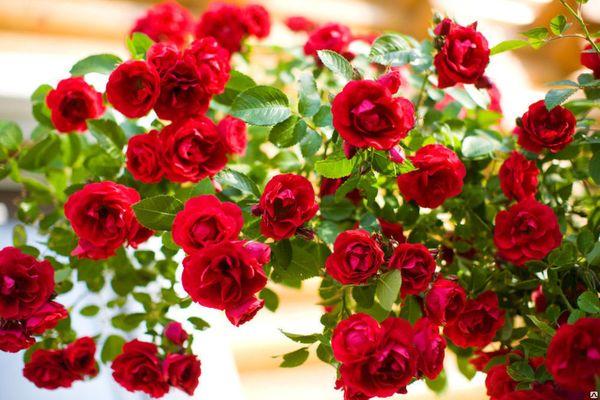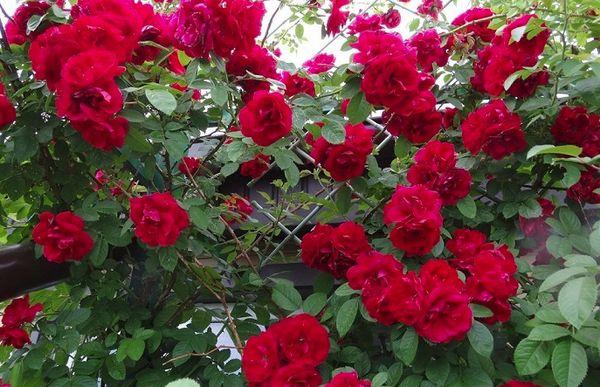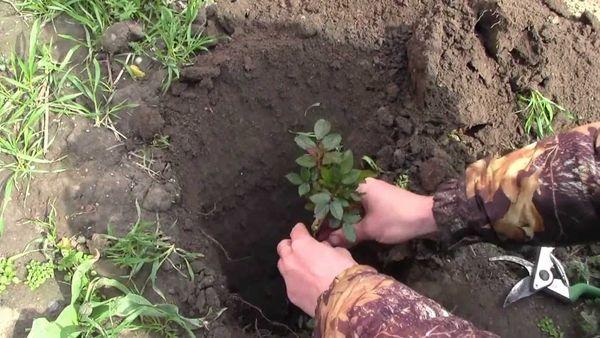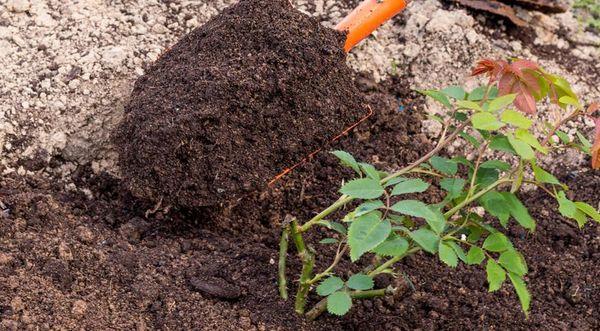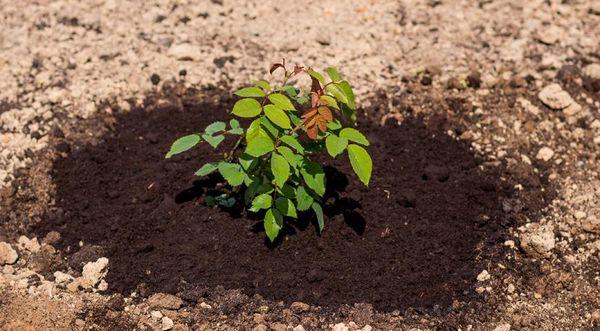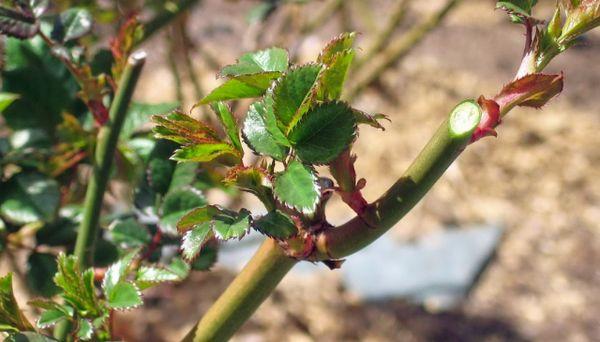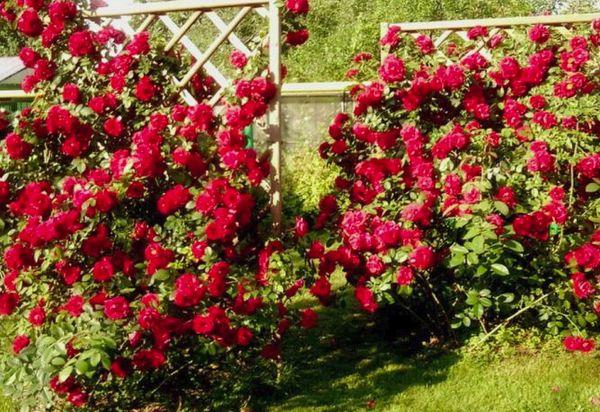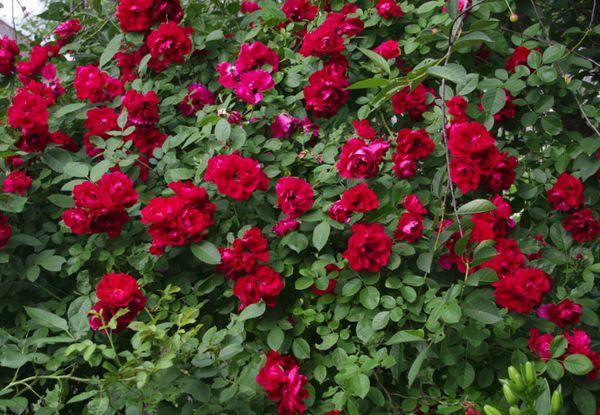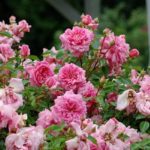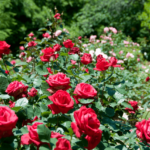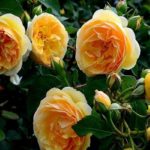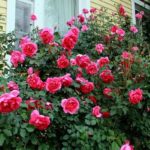Lushly blooming, with a heady aroma, the Flamentanz rose is a decoration for summer cottages and front gardens. Widely used in landscape design, as a hedge. Due to its resistance to temperature changes, it is grown not only in the southern regions, but also in Siberia.
- History of crop selection
- Difference from other types: pros and cons of the variety
- Description of the plant
- Budding and flowering
- Bush and root system
- Conditions of detention
- Lighting and location
- Temperature
- Air and humidity
- Soil composition
- Planting seedlings in open ground
- Optimal timing
- Technological process of disembarkation
- Recommendations for crop care
- Irrigation
- Fertilizer application
- Loosening the soil and controlling weeds
- Formative pruning
- Installation of support
- Sheltering bushes for the winter
- Propagation by climbing rose
- Reviews from gardeners
History of crop selection
The hybrid variety of rose Kordes Flamentanz with large bright flowers was bred in the rose gardens of the famous trading house W. Kordes’ Sohne after crossing with Rose rubiginosa in 1952. The variety was introduced to the general public three years later.
Frost-resistant hybrids with climbing branches and characteristic varietal properties are the special pride of the famous dynasty of German breeders. The name corresponds to the appearance of the plant during flowering, as translated from German it means “dance of fire.”
Difference from other types: pros and cons of the variety
Flamentanz rose differs from other varieties in its endurance and high winter hardiness.
The only drawback and distinctive property noted by Cortez himself is that it blooms once a year for a month.
The list of advantages of the variety is wider. It includes:
- resistance to pests and fungal diseases;
- withstands frosts down to -30°C;
- persistent delicate aroma;
- abundant flowering;
- rapid development of the bush, reproduction without difficulties;
- longevity;
- use in vertical gardening of household plots and summer cottages.
The height of the bush and the number of flowers on the stem depend on the correct choice of planting site and adequate care. Flower growers especially appreciate the Flamentanz rose variety for its resistance to winter temperatures. In the southern regions, bushes do without shelter, and in the northern regions, the plant is not properly insulated.
If you follow the rules for performing agrotechnical work, the rose will bloom safely in one place for up to 20 years.
Description of the plant
Cortez considered the Flamentanz hybrid to be the best among the red-flowering climbing roses he created.The fact that the bush blooms once does not prevent it from being popular in Scandinavia and among domestic flower growers.
Budding and flowering
In the southern regions of Russia, budding and flowering of the variety occurs from the second half of May to the end of June. In areas located to the north, the Flamentanz rose delights with lush flowering two weeks later.
The buds, under the weight of the petals, of which there are 20–40 pieces, tilt slightly downwards. When the bush blooms with bright red double flowers reaching 12 cm in diameter, the branches may break if not secured on supports in a timely manner. Against the background of large fiery flowers with large yellow stamens in the center, the green shiny foliage of the bush is lost and becomes less noticeable.
Depending on the composition of the soil and climatic conditions, both single specimens of flowers and lush inflorescences bloom. Up to 15 buds are formed on one stem. The aroma of Flamentanz rose is pleasant, gentle, unobtrusive.
Bush and root system
The Flamentanz rose bush is spreading, its height varies from two to five meters depending on climatic conditions. The shoots are branched with thorns, wide at the base. If you do not prune annually, the bush takes on a sloppy appearance.
The root system of the plant is well developed and powerful. It is not subject to freezing in frosty winters or rotting due to excessive rain.
Conditions of detention
In order for the varietal properties of the Flamentanz rose to be fully revealed, they follow the recommendations for creating suitable conditions for the plant.
Lighting and location
The abundance of flowering is primarily influenced by lighting. Choose a place on the south side of the site. The optimal time for the bush to be exposed to sunlight is 6–7 hours a day.Extending the lighting period leads to flowers losing color intensity.
If the right place is chosen for the rose - without drafts and close groundwater, then the plant will not require replanting for many years.
Temperature
Provided the soil is moistened, high summer temperatures are favorable for the Flamentanz rose. The variety is valuable because it adapts to different climatic conditions and can withstand temperature changes from -35 °C to +35 °C.
Air and humidity
Rose responds favorably to moderate air circulation, but categorically does not accept drafts. During the growing season, bushes are especially demanding of watering.
If there is a lack of precipitation and low air humidity, the Flamentanz rose is sprayed with a sprayer in the early morning and evening. At this time, direct sunlight on the leaves is excluded.
Soil composition
Rosa Flamentanz loves sandy loam soils with good drainage, loams containing humus, and chernozem. The plant prefers slightly acidic or neutral acidity.
Air and moisture permeability are of great importance. Stagnation of water is unacceptable. At the same time, the composition of the soil must retain a sufficient amount of moisture for the rose. Soil fertility is increased with compost and humus. Since the roots of the crop are powerful, the thickness of the arable layer should correspond to their length.
Planting seedlings in open ground
Planting material is inspected for damage, deformed or dried areas. In order for the plant to develop faster, the branches are cut to 25–30 cm, and the cuts are lubricated with garden varnish. The roots are soaked for 2–3 hours, shortened, and treated with ash.
In open ground, it is preferable to plant the Flamentanz rose together with a lump of earth. Therefore, it is better to purchase a varietal plant with a closed root system.After the event is completed, the bush is covered with film, creating greenhouse conditions.
Optimal timing
Flamentanz roses are planted in the spring before buds open, when the soil warms up to +10 °C.
The optimal planting time is late April or early May.
This period is favorable for rooting and rapid growth. If the buds of a rose seedling purchased from a nursery have opened, wait until the fruit trees begin to bloom, after which they are planted.
Planting is also allowed in the fall, but no later than the beginning of October. Otherwise, the bush will not have time to adapt and will die from the cold in winter.
Technological process of disembarkation
In order for the Flamentanz rose bushes to take root safely and delight you with abundant flowering, when planting the plants, follow the following algorithm of actions:
- prepare a planting hole half a meter deep and wide;
- maintain a distance between pits of 1 meter;
- 20-centimeter drainage is poured to the bottom - stones, fragments of brick;
- moisten the soil;
- the fertile layer of soil is mixed with half a bucket of manure or humus;
- dig in the seedling, holding it in an upright position;
- the soil is compacted from above with feet;
- water the seedling again, mulch with sawdust and bark.
For better rooting of the plant, the roots are first placed in Kornevin’s solution.
Recommendations for crop care
The Flamentanz rose variety is not demanding in terms of care, but it cannot be done without watering, fertilizing, and weeding. In order for the crop to decorate a house or summer cottage with abundant flowering every year, formative and sanitary pruning of branches is carried out, the bushes are treated with preparations that protect against insect pests and diseases, and the plant is prepared for winter.
Irrigation
On hot summer days, during the period of rapid growth of green mass, a bucket of water is poured under each rose bush twice a week.With the appearance of buds, watering is reduced to once every one and a half to two weeks.
Fertilizer application
In the spring, at the beginning of the growing season, roses are fed with complex mineral fertilizers with an emphasis on nitrogen and phosphorus. They stimulate the growth of new branches and increase the immunity of weakened roses of the Flamentanz variety - Agricola, Hera "Spring", Fertika.
Two weeks later, compost is added under each bush, burying it shallowly in the ground. A month after the first feeding, water the plants with an infusion of chicken or cow droppings. During the budding period, the bushes are sprayed with a chelated complex.
Increases frost resistance, prevents diseases and pest attacks by adding potassium fertilizers in the fall - Calimagnesia, Potassium sulfate. To increase the crop's resistance to cold and strengthen the roots, superphosphate is used.
Loosening the soil and controlling weeds
The unpretentiousness of the Flamentanz rose variety allows weeding and loosening the soil once a week. It is advisable to carry out agrotechnical measures the next day after watering, when a dense crust of soil forms under the plant.
Peat, compost, and humus used as mulch attract earthworms. Soil aeration increases, more oxygen reaches the roots.
Removing weeds reduces the risk of disease and insect attacks. The bush gets more nutrients.
Formative pruning
The first pruning of the Flamentanz variety is carried out when planting, shortening the stems by 30 cm from the root. In the second year in the spring, weak shoots are removed and the branches are shortened, leaving four buds on each. In September, damaged, deformed branches and non-lignified shoots of bushes on which buds have not formed are removed. Pinch the tops of the leading lashes.
In the third and subsequent years, in early spring, they get rid of bent branches growing inside the crown. Annual basal branches are shortened by 1/3, old ones are cut out. If there are no young shoots, then the old stems are not completely removed. Leave 20-centimeter sections to stimulate the growth of new lashes.
When formative pruning of roses, take into account that budding occurs on branches that appeared last year. Every year the lateral flowering branches are shortened to the third bud. To form the crown, powerful, beautifully directed branches are selected.
Installation of support
Before the Flamentanz rose begins to bloom, flower growers take care of the stability of the branches of the bushes and prepare support structures. When choosing a support, they are guided by reliability, compactness, and decorativeness.
Pergolas, which replace gazebos and serve as recreation areas, are built independently. Metal poles are dug in on both sides of the garden path. An arched lattice roof made of wood is attached to the top. The height of the pergola should correspond to the size of the rose bushes.
A cone-shaped support is constructed from metal and plastic pipes. Install closer to the thickened part of the plant. Plant the Flamentanz rose along a chain-link fence or make a wooden trellis mesh attached to posts.
Sheltering bushes for the winter
Shortly before the onset of cold weather, the branches of the plant are removed from their support. Under the weight of their own weight, the lashes bend to the ground. There is no need to rush to cover the bushes, since after the first frost a thaw sets in and the Flamentanz rose can trample.
Wait for a stable negative temperature (6–7°C). On a clear, sunny day, the branches are tied in bunches and laid on a layer of dry leaves, boards, and hay.In this position, the stems are secured with arches. You can do without them, but with arcs the crop is provided with access to air, which minimizes freezing and heating.
The rose is insulated on top with any covering material - spruce branches, spunbond, agrofibre, roofing felt. You can use cardboard boxes and plastic film.
Propagation by climbing rose
The most effective propagation method is cuttings. Flowering or faded shoots are selected. The bottom of the cutting is cut diagonally directly below the bud, the top is cut evenly, away from the bud.
The lower leaves are removed, the rose cutting is buried in a container with a substrate diluted with sand to a depth of 2 cm. A plastic bottle is fixed on top to create a greenhouse effect. After a month, the shelter is removed. The pot with planting material is left until planting in the ground in a room with a temperature of 25 °C. When stable heat sets in, the plant is planted in a permanent place.
Reviews from gardeners
The attitude of summer residents and flower growers towards the Flamentanz rose variety is expressed in reviews.
Irina, 33 years old:
“After building a country house, my dream came true - to grow roses. The landscape designer advised us to purchase the Flamentanz variety, which is adapted to our climatic conditions, weaves, and looks impressive on supports. I planted bushes along the fence, the south side of the house and near the gazebo. The plants survived the winter well. The next year they bloomed so profusely that there were more flowers than leaves. Care takes a little time, but how beautiful! My advice is to regularly treat your plants with chemicals. Otherwise, caterpillars and aphids will attack, which are difficult to get rid of.”
Natalya Petrovna, 45 years old:
“Five years ago, a neighbor in the country gave me a cutting of a Flamentanz rose. The plant quickly adapted to the flowerbed and began to curl.I had to ask my husband to make an arch. It blooms with red flames every June continuously for a month. Maintenance is not burdensome. In the fall, I remove the lashes and cover them with spunbond. In the spring I attach it to a support and treat it with fungicides. After the rose blooms, I remove the dried inflorescences and feed them with organic matter, ash, and superphosphate. Before wintering, I cut out old branches. Last winter I left the lashes on the arch, wrapping them with two layers of agrofibre. The bush remained intact and unharmed.”

